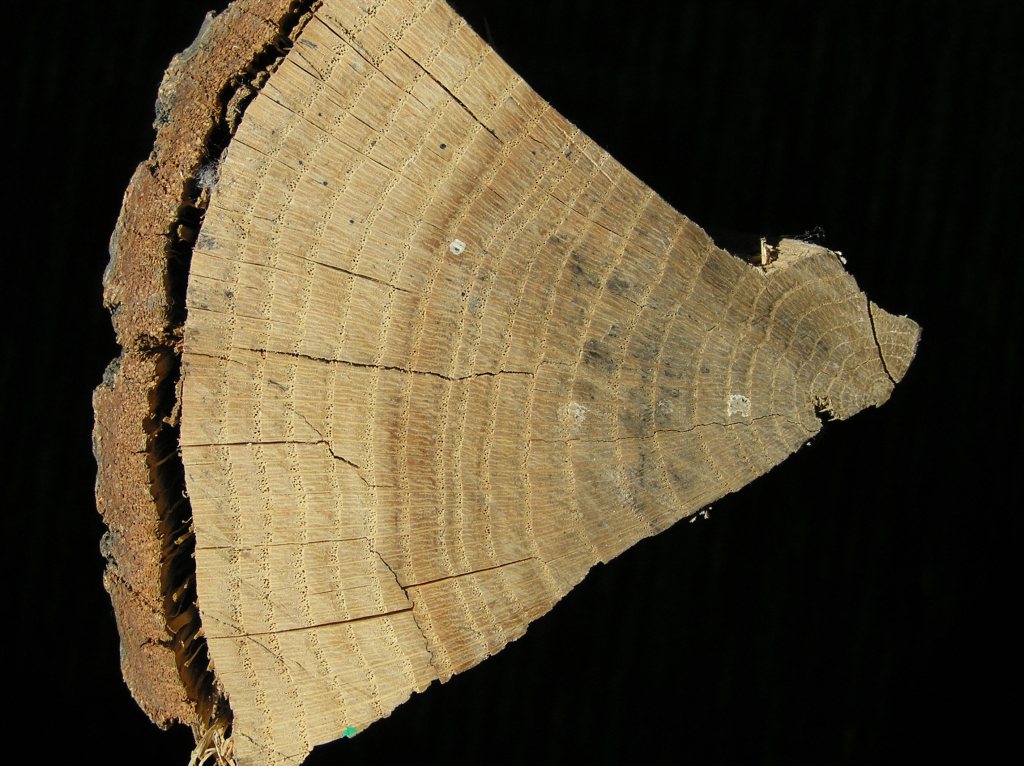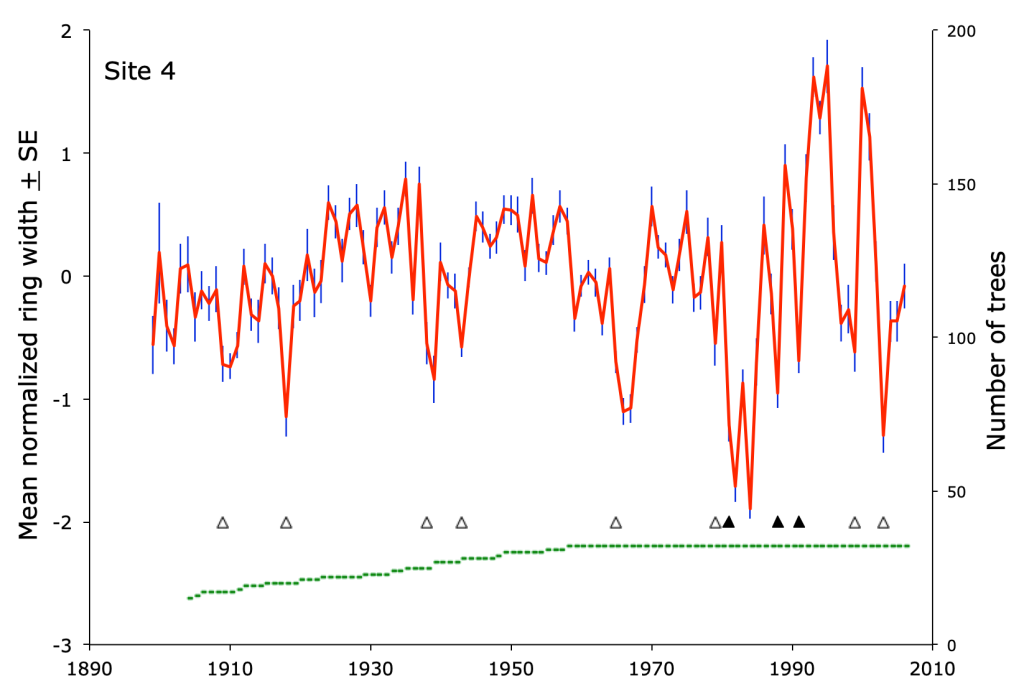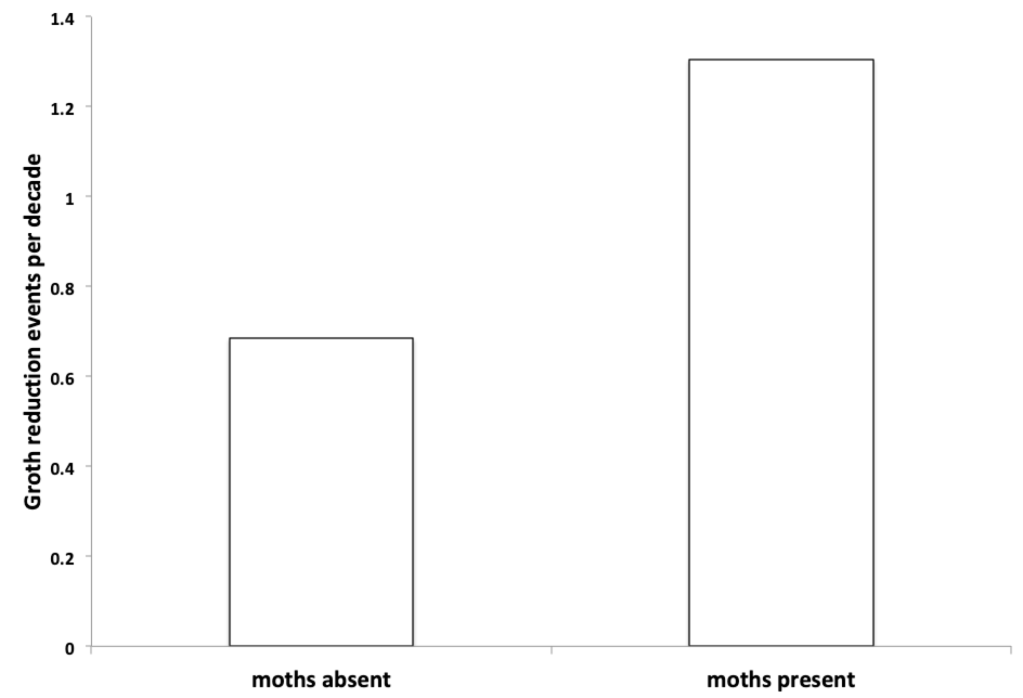
The moth Lymantria dispar has been feeding on trees in parts of North America since its introduction into the continent from Eurasia in 1869. By “feeding” I mean, “stripping every freaking leaf off” when the caterpillars are at peak abundance. In most years, the larvae are nearly impossible to find. But every so often (the frequency of outbreaks varies widely), there is a hoard of these hairy, irritating, munching critters, and trees in summer can be as bare as they are in winter. Where I live in central Massachusetts, we had an outbreak in 1981, and it was unpleasant to see the trees defoliated, to listen to the rain of droppings, and to have hoards of caterpillars all over the outside of the house. But we have had no outbreaks since, though pockets of abundance have appeared just a few miles away. We don’t know why we have been spared.
In Eurasia, these moths also boom and crash every so often, about as frequently as they do here. So they are behaving pretty much the same where they have existed for a very long time and where they have been present for only a century and a half.
How bad are they?
The moths continue to spread into new parts of the continent. When moths first arrive in an area, their initial outbreak can kill a few vulnerable trees. The percent mortality is usually in the single digits (rarely a true decimation, one out of ten). After that, tree mortality is quite low, but not zero. In 1981 near our house, a large hemlock tree surrounded by oaks was stripped bare and never recovered. In contrast, clusters of hemlocks all survived because they weren’t completely defoliated. None of the oaks and white pines died, even though they lost essentially all their leaves (the pine needles were eaten down to little stubs, but for some reason, not all the way down to the branches).
But even if the trees weren’t killed, were they affected in other ways? Yes. When trees lose all or most of their leaves, their growth slows down. How do we know? By looking at the growth rings of the trees.

This is a piece of red oak that I cut for firewood in the winter of 1988-89. I know when I cut it because of the distinctly narrow ring from 1981 when the tree was defoliated. In 1981, the tree began to grow in the spring (the coarse cells in the inner portion of the ring) but then grew slowly or not at all until the larvae had finished eating and new leaves could form in the summer. Counting out from 1981, the last ring is 1988 (the one just inside the bark). I cut this tree after the growing season of 1988, but before any growth could occur in 1989.
Tree rings reveal good years and bad years of growth, and insect attack is only one of many possible causes. Shade from other trees produce consistently narrow rings (until the tree casting the shade dies). Drought can slow growth, especially in trees that are rooted in soils that don’t hold a lot of water. Injury to the tree can also be a problem if it is serious. And feeding by many species of insects, indigenous and introduced, can damage trees.
Questions
Has the arrival of Lymantria moths increased the frequency, duration and/or amount of growth reduction in oak trees? Or are moth outbreaks just another cause of growth reduction among those already apparent in the tree ring record?
I tried to answer these questions at six sites in Pennsylvania and New Jersey where the first outbreaks of these moths were well documented by the state forestry departments. I measured the tree rings before and after the first outbreaks, and used observations from foresters, and published records of drought severity, to determine (when possible) the cause of significant declines in growth.

Tree growth, as recorded in the width of tree rings, varies widely over time. Different trees grow at different rates for all kinds of reasons, including genetics, neighbors, soil, weather, and so on. To reduce the individual differences among trees, space, and time, dendroecologists detrend, normalize, and average the results for dozens of trees at a site. The result looks like this graph from site 4 in Pennsylvania.
Years of low growth
At the six sites, there were 529 site-years with at least fifteen trees present. In 78 of those site-years (15%), growth was reduced by at least one half of a standard deviation.

Fifty-one of the reductions were in drought years, 29 occurred during outbreaks of Lymantria (19 of which were also drought years), nine were associated with outbreaks of indigenous insects (oak leaf tier, oak leaf roller, and scale insects), and two occurred when there was evidence of fungal disease. For eight of the growth reductions, I couldn’t find anything in the drought or forestry records that was associated with low growth.
The magnitude of growth reduction varied widely, but on average, Lymantria outbreaks caused greater reductions in growth than droughts. The mean reduction of growth in drought years was -0.69. When moths were present during droughts, the mean reduction in growth was -0.94. During outbreaks when there was no drought, the mean reduction in growth was -1.20.

But the plot of these results shows something interesting. Growth reductions usually ranged between -0.5 and -1.2 for drought only, drought plus moths, and moths only. In five cases, growth plummeted by more than -1.5. At their worst, Lymantria outbreaks caused the greatest reductions in tree growth over nearly a century. On the other hand, they did so only five times between the time outbreaks began until 2006 (when my data collection ended).
Events of low growth
Reductions in growth often lasted for more than one year at a site. Droughts and insect outbreaks might end after one growing season, or continue for several years. Has the arrival of Lymantria moths changed these events, compared to growth reductions before they arrived?

Before there were outbreaks of Lymantria, growth reduction occurred less than once per decade at the six sites. After moth outbreaks began, growth reduction was about twice as frequent, well over one per decade. It is impossible to know why the frequency increased, but this invasive moth almost certainly contributed to the increase.

On average, growth reduction events lasted 1.7 years when moths were absent. Duration increased somewhat, to 1.9 years, once moths were present at the study sites. This difference is not statistically significant, and probably not ecologically significant.

The maximum amount of growth reduction during an event increased quite a bit once moths arrived, going from an average of -0.74 down to -1.01. An outbreak of Lymantria moths can be a big deal for tree growth.

But so can an outbreak of the indigenous oak leafroller, Archips semiferanus. At site three, the outbreak began in 1970 and lasted three years, reducing tree ring width to -1.62 in 1972.
After nearly every outbreak of an insect defoliator, whether invasive or indigenous, tree growth quickly shot up to values among the highest seen in the entire tree-ring record. The trees are resilient, for whatever reason, after severe damage from herbivores.
How bad is this invasive insect
There are plenty of invasive pests that are serious problems, none worse than the chestnut blight that wiped out American chestnuts in the twentieth century. Today, the emerald ash borer is killing lots of ash trees, and the hemlock woolly adelgid is killing lots of hemlocks. If we can stop the spread of these introduced pests, we can save a lot of trees.
How serious is Lymantria dispar? Outbreaks of these caterpillars can kill trees, and the survivors have reduced tree growth. Also, the frequency and intensity of growth reduction has increased since the moths arrived.
On the other hand, outbreaks are infrequent, few trees are killed, and the surviving trees seem to bounce back readily after an outbreak. The moths have affected tree growth, but have not radically altered our forests.
Perhaps most significant, there is nothing we can do to stop the spread of this moth. It continues to disperse west, south and north since its release in Massachusetts over a century ago. We will have to tolerate its presence, just as people – and forests – do across Eurasia. We have no choice.
By the way, if you have never heard of the spongy moth, it is because it is the new name for the gypsy moth. The old common name for Lymantria dispar is ethnically insulting, so it has been changed https://www.nytimes.com/2022/03/03/science/spongy-moth-romani.html
Leave a comment